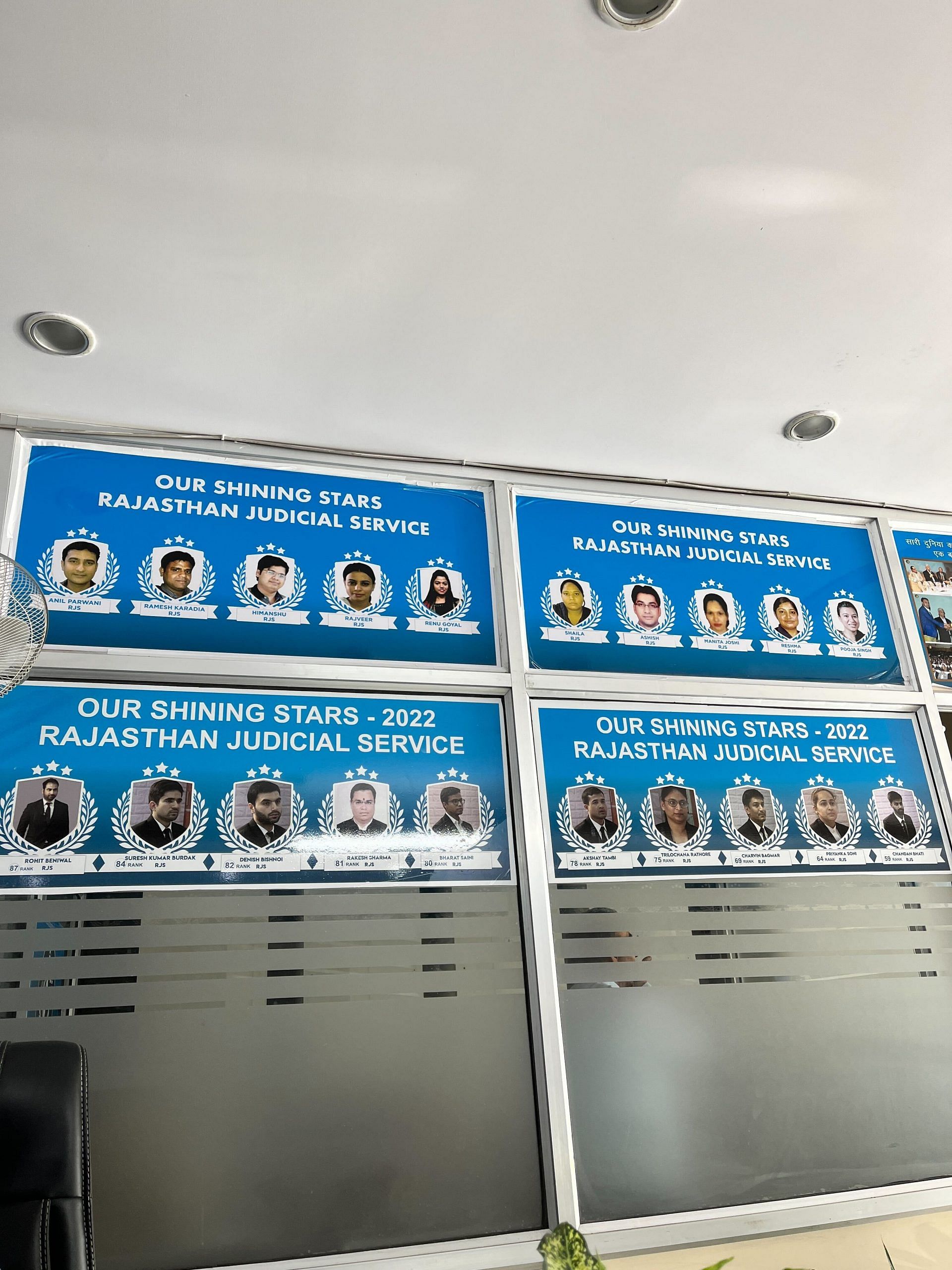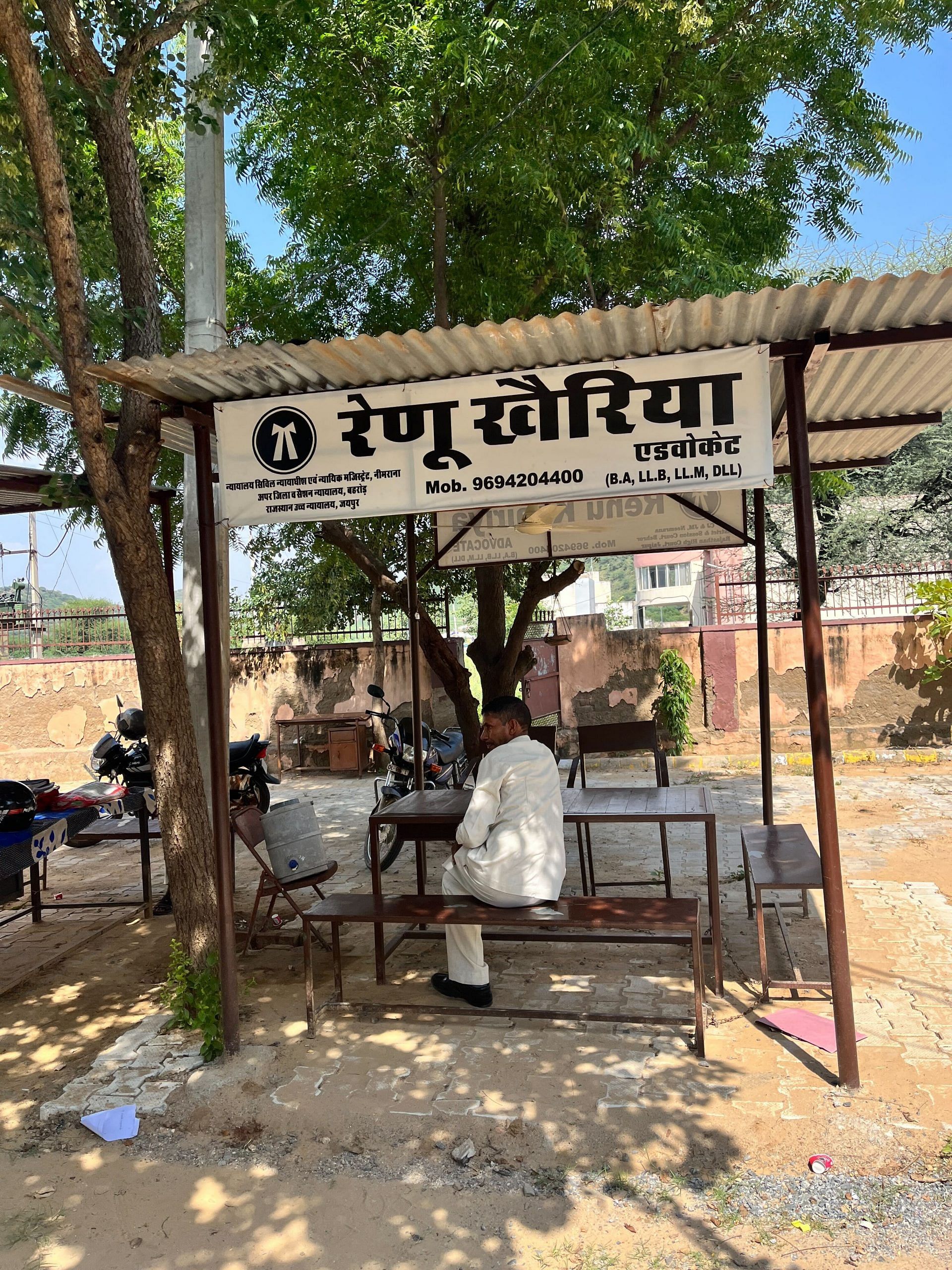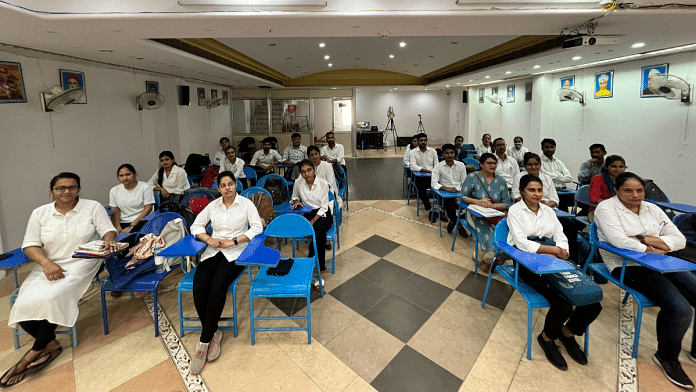Jaipur: Five years ago, Ankita Sharma watched helplessly as the cleaner at her college struggled to survive an abusive marriage. As a BA student in college, Sharma was unable to help the woman who had married a man from Bharatpur district in Rajasthan. Sharma’s inability to help the woman made her realise how little she knew of the cases, courts and the Constitution.
Determined to rectify this, she got a law degree from a private college in Rajasthan, and is now preparing to qualify as a judge. Today, at 25 years, she can quote tedious laws, and explain sections of various Acts. It’s her way of making a difference, of seizing agency.
Sharma is among thousands of female judge aspirants across this northern Indian state. It’s a sign of young Indian women’s drive to intervene in the public arena and vitiate structural changes in the matter of women’s safety and rights. “Similar tales across villages and towns occupy the public discourse. But these women have no knowledge of their rights. One feels helpless,” she said.
With her understanding of India’s labyrinthine legal system, the 25-year-old law graduate from Jaipur has helped many women—almost all are victims of abuse. Sitting in a judicial coaching classroom in Jaipur’s Rajasthali law institute, she has more than one compelling reason to join the female cadre. “These cases keep coming to you and you are not able to help in any way if you are not empowered yourself,” she says.
Sharma points to a news clip on the Bilkis Bano case where the convicts were released by the Gujarat government under its remission policy.
“This enrages me,” she says.
According to Sanjula Thanvi, dean of the law faculty at the University of Rajasthan, many women seeking law degrees have themselves been subjected to domestic violence or their rights are abused in other familial matters. “And some are like Ankita. There is this urgency among women to get into the legal field and change their status quo,” says Thanvi.
“States like Haryana and Rajasthan, which once made headlines for female foeticide, khaps, and regressive systems, are now being discussed for their women making careers in the legal fraternity and gender representation in subordinate judiciary. This is most certainly a happy and encouraging trend,” retired Supreme Court Justice Gyan Sudha Mishra commented.
She added that it took almost 72 years to get the first woman judge directly elevated from the Bar in the Rajasthan High Court in the year 2021. “We have yet to reach an ideal level of reformation.”
Mishra, born and brought up in Bihar’s Patna, moved to New Delhi in the 1970s to practice in the Supreme court. She went on to become a Patna High Court Justice and later served in the Rajasthan High Court as well. In late 2000, she became the first female chief justice of the Jharkhand High Court.
She lays down the number of challenges that lie ahead of the female cadre. “Climbing up the ladder in higher judiciary is as great a challenge as elevation in higher courts by promotion—it is not a smooth sail. Most get stuck in the mid-level in the district.” But she also emphasises that despite all this, the process of change will not stop.
“I gave an assignment to a district judge while I was serving as the chief justice of Jharkhand. When he could not complete the task, he commented in Bhojpuri, ‘Nahrani se gacchi kataiti? (Would a nail cutter cut a tree?).’ I transferred him after this, but look at how men enjoy a superiority complex in every power circle.”
Mishra added that women in power positions have changed their mindset marginally. “But the discrimination stays in an abstract form. As a woman you can feel it,” she said.
She recalled how, during her welcome speech as chief justice, the advocate general referred to her as a sisterly figure. “I don’t remember how I reacted back then but we are still not able to acknowledge women by the virtue of their positions. So, women are always sisterly and motherly figures to the most,” she pointed out.
Mishra added that as the young women from recent batches begin their careers as civil judges in junior divisions of district courts, an army of female district judges is expected in the near future. “But this is not translating into a change in the higher judiciary.”

Also read: Stalkers, creepy 1 am emails, flowers – What two women judges in small towns battled
Inspiring the new generation
The trend is evident in the judicial services exam statistics too. The latest Rajasthan Judicial Service (RJS) 2022 results demonstrate that women are not just topping the exams, but also outnumbering men.
‘Women top the RJS once again, out of top 10 candidates, eight are women’: Such headlines made the front page of Hindi national dailies in August this year.
The city’s billboard skyline features glamorous female models in Lakme mascara, luxury, and jewellery commercials, and now judicial exam toppers. A row of mugshots appears on giant hoardings heralding the newest batch of women judges – expanding the meaning of glamour and raising the bar a wee bit more for tens of thousands of young girls.
Of the 120 candidates who were selected for the judiciary this year, 71 were women, shows data from the Rajasthan High Court.
The batch will start judicial training in December, but their success stories have already started circulating on social media, inspiring a new generation of young women and school girls.
Also read: Large number of women to adorn posts in judiciary very soon, says CJI Lalit
30% reservation, CLAT and yearly vacancies
There’s a silent revolution stealthily making waves across North India’s small towns. Daughters are confronting their mothers and fathers with demands to go to law colleges. They counter the derisive arguments put forth by their brothers and elders. Women who have escaped abusive relationships are drawing strength from a legal education. And school girls dream of becoming judges.
What caused the floodgates to open? Popular culture has yet to make sense of this trend, but legal experts say that in Rajasthan’s case, reservation for women in the judiciary gave an impetus to this trend.
Women in Rajasthan are entitled to 30 per cent reservation in the judiciary. Of this, a third is allotted to women who have lost their husbands and those who are divorced in an 80:20 ratio.
This paved the way for first-generation learners in remote areas, tilting the gender imbalance and ushering in diversity in the classroom.
The adoption of the Common Law Admission Test or CLAT along with yearly judicial vacancies and a fair examination system have also contributed to the overwhelming number of women, say those who run coaching centres. All these factors propelled a “boom” in legal education.
“There was a saying that those who don’t do anything end up doing law. Usually, it is a wanderer’s course, a man’s course. But after CLAT, more colleges were established in districts, and more women started enrolling for professional degrees like law,” said a district judge.
It was in 2008 that CLAT was first conducted by National Law Schools of India University (NLSIU). “With this, national law colleges followed suit,” the district judge added. Coaching centres and educational institutions were the first to notice the trend. And suddenly, law became a hot subject.
Another big change took place in 2016 when the Rajasthan High Court started conducting the RJS instead of the Rajasthan Public Service Commission. The change of guard introduced more transparency into a once rather opaque selection process.
“Under the RPSC, there were irregular vacancies (sometimes a 4-5 year gap) and the selection process was flawed,” said JB Khan, who runs a coaching centre in Churu district. His sister-in-law was a part of the 2006 batch that challenged the RPSC selection process in the higher courts. She is currently at the ADJ rank in a district court, he says proudly.
Also read: Ramana’s collegium didn’t diversify judiciary. Data shows most judges are upper-caste Hindus
Women in the front seats
Jaipur’s Gopalpura bypass main road is teeming with women in track pants, trousers and salwar-kameez. They walk with purpose. Armed with their law textbooks in one hand, and their tiffin and water bottle in the other, they head to the various coaching centres that line the road.
The lanes are plastered with giant hoardings flaunting the top rankers – again, most are women. Here, in Jaipur’s coaching hub, banners proclaim promises of top ranks, good mentorship and guaranteed success. There are as many as 7 RJS-dedicated law coaching centres in the area, and new ones are still coming up.
Allen, the Kota king in the world of coaching institutes, is also set to ‘launch’ its first batch of RJS aspirants.
“This is big. The success stories of women are reaching everywhere,” an owner of a coaching centre said.
The institute where Sharma is enrolled in has 120 judiciary aspirants, 80 per cent of whom are women. Some are chartered accountants, others are engineers. All have law degrees, and now they want to be judges.
Sharma sits in the front row along with Priyanka Goenka, Divya Sharma, and Sonakshi Parik. They take down important points from the lecture and highlight key phrases in their textbooks. Their confidence belies the self-doubt they battled on the arduous journey to reach that classroom.
Almost all the women have a story to tell. When an upper-caste Sikar woman announced that she was going to study law and try becoming a judge, her parents were aghast. She was told that no woman in the family dared to do this.
“You are allowed to study as much as you can. But no job. My brother told me that in our community women are not allowed to pursue occupations that involve dealing with criminals,” said a student in the classroom who did not wish to be named.
Another female aspirant from Alwar, a domestic violence survivor, decided to take things into her own hands. “Once my marriage ended, all hell broke loose. In my community, the end of marriage is considered the end of life. Along with fighting stigma, the fight to claim my agency within my family and the community is still underway,” she said.
But that day, they all sat down to study the Indian Evidence Act, 1872.
Sharma raises her hand to clarify her doubt about ‘relevancy of facts’ in the Act. Her teacher MK Singh praises her confidence before answering her. The judicial coaching course also covers sensitive subjects such as POCSO, rape, and Section 377 of the Indian Penal Code (IPC).
“It was so different when we started [teaching] in 2008. I was very shy about teaching some sections in front of female aspirants that dealt with sexuality. But we have come a long way. You see these bright and confident faces,” says Singh, who started Rajasthali Law Institute in the late 2000s.
Every student writes what they want to specialise in on the first page of the notebook. Many women said they wanted assignments related to POCSO cases, others wanted to do more “women-related cases”.
But not all of them will be selected to become judges. Competition for a limited number of seats is stiff, especially as more people are attempting to sit for the examination.
Sharma, who grew up in Kaman, a small town in Bharatpur, insists that “it won’t make a difference” if she doesn’t make the cut. “If I don’t clear this, I may become a lawyer,” she says.

Stigma to status
Back in 1994, when Sanjula Thanvi got her LLB degree from the very same department that she now heads, things were not easy for women. Marriage prospects for law graduates were few and far between. Those who succeeded in getting a law degree found that there was little career growth unless they moved to bigger cities.
“Some jobs were once thought to render women un-marriageable because they fuelled insecurities among their male counterparts. It was true for the police as well. But the glass ceiling in policing and administrative services was broken long back. Judicial services are witnessing the change now,” Thanvi said.
Women lawyers and judges were criticised for the same virtues that were extolled among their male colleagues.
“Top opinionated, too empowered – people used to say about us. And who would believe that even my husband was advised by his relatives against marrying me,” says Thanvi chuckling.
Such stereotypes still exist, but for the most part, the stigma of marrying a judge has become a status symbol in small towns.
“RJS bahu/beti is a status—at least socially,” says Rajani Yadav, who secured the 54th rank in this year’s RJS exam. The BCom graduate from a small town called Kotputli in Jaipur district had a tough time convincing her parents to allow her to get a legal education.
“My family is in the teaching profession. They had no idea about the judiciary and law. So when I expressed my desire to pursue an LLB degree, my father protested. There was no limit to their worrying. After all, who marries a woman in the legal profession,” said Yadav.
However, after initial opposition, and with the surprising support of her grandparents, they gave in.
In three decades, the situation has altered drastically. Lower courts, especially those that are seeing the appointment of women judges, have a lot to offer to their female cadre.
“Women wanted to join the judicial service even in 2000 but there were fewer options back then. Now, you have better infrastructure, safety and security, and a good pay scale,” said Sonia Shandilya, a third-generation advocate who practices in the Rajasthan
Parents, too, are more receptive to their daughters becoming judges than lawyers.
“It takes years to establish oneself as a lawyer. Also, it’s widely known to be a field of exploitation in women’s cases. In the judiciary, you can raise the family in your spare time and also build your career,” says a young lawyer practising in the Neemrana Gram Nyayalaya. She missed the RJS 2022 cut-off by two marks.
The 10am-to-5pm office hours have also changed the perception among families. Perks such as good pay, security, housing and other benefits are a lure as well. Every middle-class family from teachers to lecturers to shop owners and local businessmen has the list of these perks at their finger tips.
“You are more powerful than an IPS or an IAS officer. Even if you are an SP or a DM, you can be called at any hour with MLAs and MPs asking for favours. The day you become a civil judge, you will be drawing a salary much more than them. Anybody can criticise the CM and the PM, but nobody can point a finger at a magistrate,” says MK Singh extolling the merits of becoming a judge to his students. Sharma and her classmates nod excitedly, their eyes shining with the prospect of entering this world.
Back at the reception, the coaching centre’s manager gives the same spiel to a young female ‘client’, who is accompanied by her brother, mother and father.
“Women who want to become judges and are going to coaching centres have already fought and won the battle at home. They have a law degree,” said Yadav.
This is part of a series on women judges in India’s lower judiciary. Read all the articles here.
(Edited by Tarannum Khan)






